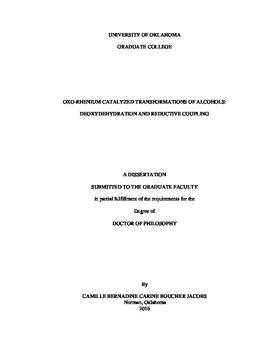| dc.contributor.advisor | Nicholas, Kenneth M. | |
| dc.contributor.author | Boucher-Jacobs, Camille | |
| dc.date.accessioned | 2016-08-18T20:04:21Z | |
| dc.date.available | 2016-08-18T20:04:21Z | |
| dc.date.issued | 2016-08 | |
| dc.identifier.uri | https://hdl.handle.net/11244/44915 | |
| dc.description.abstract | One of the challenges for the future is to find alternative energy and chemical resources to petrol. Biomass-derived feedstocks offer a renewable source of highly oxygenated molecules. Recent chemical processes for the efficient and selective deoxygenation and refunctionalization of these renewable chemical resources are being developed such as: dehydration, deoxygenation and deoxydehydration (DODH). The latter is the removal of vicinal OH groups and the formation of C-C unsaturation producing value-added unsaturated products that find uses as laboratory and industrial intermediates and end-products.
Chapter II reports the study of a new class of reducing agent for the DODH reaction: hydroaromatics. In this study we tested the activity as DODH reducing agent with a range of hydroaromatics. We found several to be reactive and providing good yields. Two of them were found to not only be good DODH reducing agents but also to involve the alkene product in a cycloaddition. Indoline was found to be the most reactive of all and could be applied to a larger survey of diols. This superior reactivity of indoline was explained by the formation of indoline-rhenium complex which was isolated and its structure was solved with an X-ray crystal structure.
Chapter III covers the efforts we made in the development of DODH/C-C bond formation tandem reactions. The concept of these tandem reactions was to have the DODH reaction directly followed by a C-C bond reactions such as: Hetero Diels Alder, Allylation, Hydroacylation, Heck, Hydroformylation, Alkene metathesis and Wittig reactions. The compatibility of reagents and reaction conditions was the most challenging part of these tandem reactions. From all these we found some compromises between each of the sides of the tandem reactions and could observe DODH/C-C bond forming tandem reactions.
The last chapter covers the mechanistic study of IReO2(PPh3)2 catalyzed reductive coupling of activated alcohols. In this reaction activated alcohols form alkane dimers. Stoichiometric, kinetic and computational (by K. Nicholas) studies were conducted to find and support potential catalyst intermediates. Combining the information from each of these studies we could propose a potential catalytic cycle. | en_US |
| dc.language | en_US | en_US |
| dc.subject | deoxydehydration | en_US |
| dc.subject | oxo-rhenium catalyst | en_US |
| dc.subject | alcohols and glycols | en_US |
| dc.subject | reductive coupling | en_US |
| dc.title | Oxo-Rhenium Catalyzed Transformation of Alcohols: Deoxydehydration and Reductive Coupling | en_US |
| dc.contributor.committeeMember | Crossley, Steven P. | |
| dc.contributor.committeeMember | Glatzhofer, Daniel T. | |
| dc.contributor.committeeMember | Halterman, Ronald L. | |
| dc.contributor.committeeMember | Thomson, Robert K. | |
| dc.date.manuscript | 2016-08 | |
| dc.thesis.degree | Ph.D. | en_US |
| ou.group | College of Arts and Sciences::Department of Chemistry and Biochemistry | en_US |
